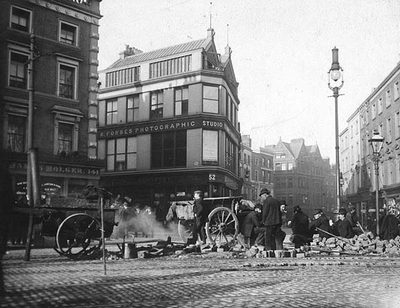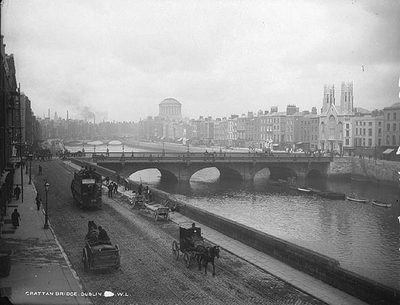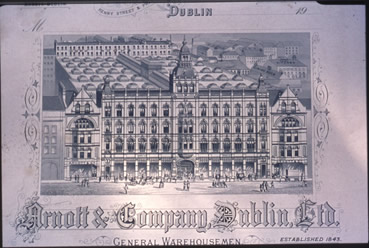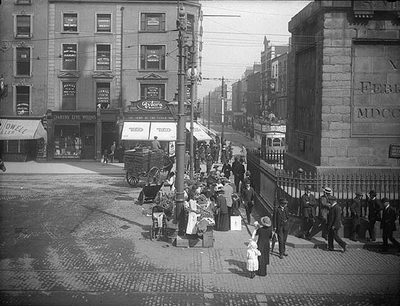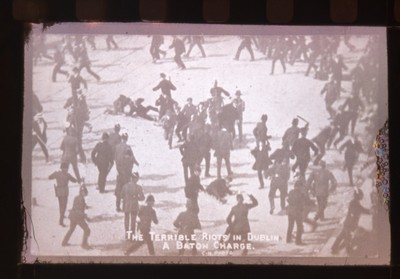Commerce, employment and trade unions
View the photo galleryThere was virtually no evidence of economic growth in Dublin in 1911. Many of the traditional industries in the city were struggling to survive, let alone prosper. Work in construction and in the port was inadequate to absorb the surplus labour pool. There were few new firms opening, no sense of a thriving industrial city. Occasional brilliant moments of innovation and development were notable for their infrequency. Instead, the city was riven with industrial disputes.
The trade union movement was determined to improve the appalling conditions of the working classes and confrontation with employers was looming. Such was the stagnation in manufacturing that by 1911 the percentage of the workforce employed in that sector was down to 20% from 33% in 1841.
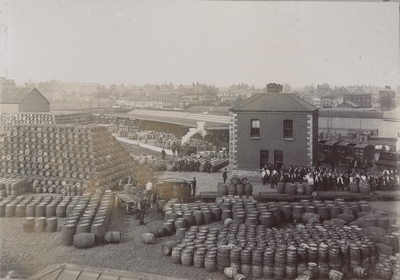
A view across the cask yard, St. James’s Gate Brewery c. 1906-13. Guinness was one of the city’s ‘outstanding employers’.
(Guinness Archive, Diageo Ireland, GDB.BR14.0014.18)
Industry in Dublin, with a few notable exceptions, was geared towards production for the finite home market, and faced challenges from imported goods, although a lot of what was bought in the city was made in the city. There were people making coffins, like Moore of Canning Place, North Dock, clocks, like Bond of Sth Frederick St., cabinets, like Ridd of Millmount Ave., Drumcondra, brushes, like Cann of Dargle Rd., Drumcondra, mattresses, like Bouchier of Clarendon St., combs, like Mitchell of Strand Rd., Sandymount, umbrellas, like Betts of Rock Rd., Blackrock, tobacco pipes, like Corcoran of Emmet Square, Blackrock and cigarettes, like Bradbury of Lower Abbey St.
Many of the old trades of the city survived. There were chandlers like O’Connor of Hollybrook Park, Clontarf, ironmongers, like Mitchell of Quarry, near Howth, sawyers, like McCluskey of Lower Gloucester St., coopers, like O’Reilly of Manor St., bottle blowers, like Sharkey of Great Brunswick Street, horse-shoers, like Carroll of Frederick Lane, apothecaries, like Martin of Tallaght Town and all manner of smiths: blacksmiths, like Ward of Healy St., whitesmiths, like Butler of York Road, coppersmiths, like Swift of Emmet Rd., Kilmainham, and goldsmiths, like Barry of Crumlin Rd.
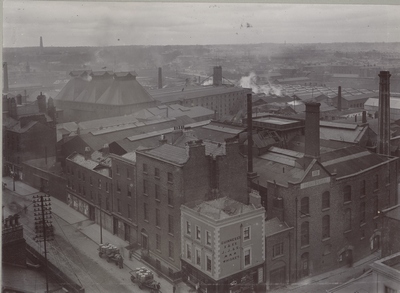
A view across the rooftops at St. Jamesís brewery c. 1906-13
(Guinness Archive, Diageo Ireland, GDB.BR14.0014.24)
As a reminder that Dublin was an agricultural town as well as a capital city, there were also farm labourers, like Timmons of Tenter Lane, and field workers, like Jones of Church St., living in the heart of the city, as well as cowkeepers, like Collins of Chatham St., cattle drovers, like Malone of Upper Grangegorman, shepherds, like MacDermott of Gardiner's Row, Blackrock, and herdsmen, like Butler of New Church St.
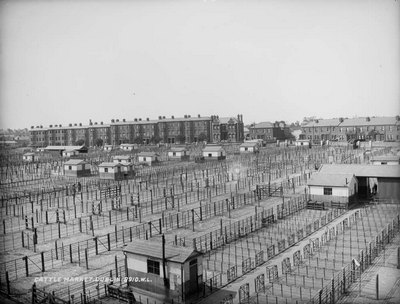
Dublin was an agricultural town as well as a capital city. This photograph shows the Dublin cattle market c. 1900
(NLI, LROY 8910)
In 1911 the textile industry still survived in the city (see Vallom family in Lucan Town) notably in the Liberties, with almost two hundred active looms, but the cotton industry had collapsed and the city had been inundated with cheaply produced English clothes after the 1860s. There were still silk weavers, like Murphy of Brabazon St, and flax dressers, like Boyle of Coombe Cottages, and all around Greenmount Lane in Rathmines (see Hall and Hayden of Greenmount Lane) there were numerous linen weavers and winders.
Across the city women sought to supplement their income making bags, like McGanley of Church Ave., vests, like Reardon of Ormond Quay, dresses, like Coffey of Killarney Parade, and much else. Individuals were unable to compete with the big mills, however (see return for mill engineer Willam Baggett of Westmanstown, Lucan).
Ship-building had all but disappeared from Dublin port until the Dublin Dockyard Company revived it in 1901 (see return for shipbuilder Smellie of Hollybrook Road). There were also companies engaged in the manufacture of matches (see return for Managing Director of Patterson’s, Cooper of Simmonscourt), chemicals (Vitriol Works, Poplar Row, North Strand) and confectionery, with Jacob’s biscuit factory in Bishop St, for example, employing more than 3000 people, like Lynn from nearby Kevin St., many of them women, like Kelly, also in Kevin St.
There were some outstanding employers in the city, notably Guinness's Brewery, a company with a long reputation for treating their workforce in a decent manner. With good job security and above-average wages, a job at Guinness was highly prized (see employee Ferry from Manor St.). Distillers like Jameson of Malahide were also major employers. Jobs in the transport sector were coveted. Dublin had traditionally been the centre of the coach-building industry (see return for coachbuilder Sankey of Healy St.) and, by 1910, surviving firms in the city such as Huttons had diversified into motor cars.
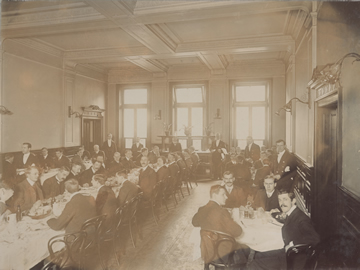
Guinness had a 'reputation for treating their workforce in a decent manner.' This photograph shows the staff dining room at St. James's Gate Brewery c. 1906-13
(Guinness Archive, Diageo Ireland, GDB.BR14.0014.35)
The major plantworks in the Inchicore and Phibsboro areas belonging to companies such as the Great Southern and Western Railway Company (see workers living in Great Western Square, Phibsborough) and the Dublin United Tramway Company (see employee Maher Shelbourne Rd.) gave valuable employment to skilled and semi-skilled workers, as well as to labourers.
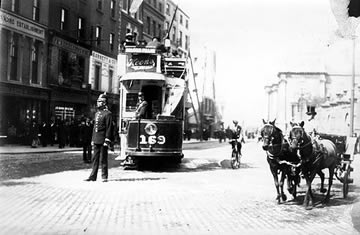
A tram passes the corner of Grafton Street and Nassau Street c. 1900. The Dublin United Tramway Company gave 'valuable employment to skilled and semi-skilled workers, as well as to labourers'.
(NLI, CLAR 62)
On a smaller scale, there were some elements of business life in the city which could claim to be as advanced as, or even ahead of, the rest of the world. On Observatory Lane, at the Rathmines Road, there was a remarkable telescope-making factory owned by Sir Howard Grubb, who lived on Orwell Road in Rathgar. The company made telescopes for various governments across the world, including the Dunsink Observatory (see return for Whittaker of Dunsink), and two telescopes made for the Tsarist regime just before the revolution were subsequently paid for by the new Bolshevik government.
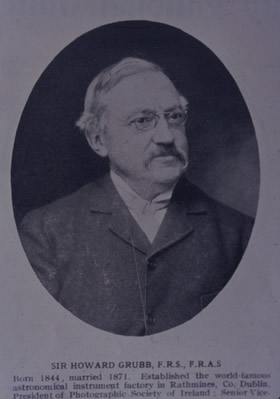
Sir Howard Grubb, who established a telescope-making factory in Rathmines.
(DCLA, Dixon Slide 42.99)
Guglielmo Marconi was also engaged in pioneering the use of wireless from his base in Dublin. Marconi had been born in Italy but his mother was Annie Jameson, from the wealthy Irish whiskey-distilling family. In July 1897 he had transmitted the first-ever live report of a sporting event when he commented on a race at the Kingstown regatta from a steamboat in the bay, and he continued to experiment with radio all across Ireland.
There were other areas of innovation, including the presence in the city of an artificial leg maker (Dearle of Chatham St.) and of scientific instrument makers (Bennett of Brookfield Buildings, Blackrock). And Dublin was also inevitably following changes in other economies with its new class of electricians (Dalton of Dargle Rd., Drumcondra), electrical engineers (Jones of Gracepark Ave., Drumcondra), and electric lift attendants (Pearson of Summer St.). Generally, though, Dublin had failed to innovate and had fallen behind Belfast in almost every area of business.
Dublin was an important legal (Brady of Hollybrook Park), financial and commercial centre, even if it was a provincial one. There was a lucrative trade in selling advertising (O’Toole of Capel St.). The major banks (see return for Bristow of Upper Sackville St.) were based in Dublin, as were the Irish headquarters of the large British insurance companies. The city also had a large stock exchange which had been established by a 1799 bill to regulate the growing number of stockbrokers in the city (see household returm for Goodbody of Mount Merrion Ave., Blackrock).
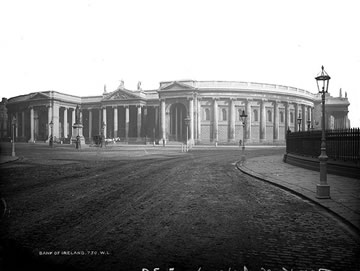
Dublin was home to a number of banks. This photograph shows the famous Bank of Ireland building on College Green c. 1900.
(NLI, LROY 730 )
It was also a city where many owed their employment to the government. As well as departmental officials, there was a growing number of people employed by the state to work as firemen, like Bride of Corporation Buildings, postmen, like Keegan of Capel St., and lamplighters, like Lallon of Eccles St.
By 1911 the city's retail trade was also changing. The second half of the nineteenth century had seen the arrival of major department stores. Eason's opened in 1886 as a major bookseller and newsagent (see return for Charles Eason of Cunningham Rd., Dalkey), and Brown Thomas and Clery’s were also operational. There was criticism in some quarters of the fact that two of the major department stores, McBirneys and Arnotts, were owned by a Scot and an Englishman, respectively. However, the majority of the city's people shopped in small local shops, like Curran's of Main St., Blackrock, in the many markets that were scattered across Dublin, or bought from the army of women and children who sold goods on the street .
The presence of so many women (see return for dealer Mary McCarthy of Lower Gloucester Place) and children selling on the street was indicative of the precarious nature of employment in the city. The fortunate few with skilled and semi-skilled work enjoyed a reasonably secure existence, but even here there were problems as wages had not risen appreciably since the 1870s. Further, many skilled workers were unemployed.
The unskilled labourers of the city were fortunate to be earning even 18 shillings per week for work that was often casual, broken and seasonal. There were estimated to be 24,000 men, one quarter of the adult males of the city, dependent on such labour and many went weeks and months without any work at all (see return for Keegan of Paradise Place).
Profound disenchantment had led to unprecedented labour disputes in the city between 1889 and 1891. In 1893, the Irish Trade Union Congress had been established to draw together the disparate unions in the city, but it was the employers who won most labour disputes (see return for union organiser Walter Halls of Millbourne Ave., Drumcondra). James Larkin helped to reorganise and radicalise the trade union movement, both in Dublin and nationally. Larkin established the Irish Transport and General Workers’ Union in 1909 and by 1911, the union had 18,000 men in its ranks. Women, too, were mobilising. In 1911 the Irish Women Workers’ Union was founded with Delia Larkin, James’s sister, as its first general secretary.
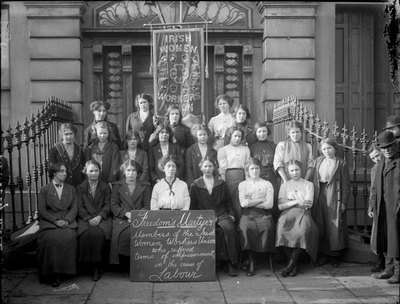
Members of the Irish Women’s Workers’ Union on the steps of Liberty Hall, c. 1914. The Union was founded in 1911.
(NLI, KE 204)
The response from employers was trenchant. William Martin Murphy was the most prominent businessman in the city. He owned railways, tramways, Clery’s department store, the Imperial Hotel and critically, the Irish Independent newspaper. He was at the heart of the reaction against the growing militancy of labour and established the Dublin Employer’s Federation. Conflict seemed inevitable. Across the city there was a rise in labour disputes.
In 1911 there was a wave of strikes. The bakers' union engaged in a strike which was the culmination of two decades of disputes over work practices and pay. They lost. A railway strike also ended in an abject defeat for workers who had taken on the Great Southern and Western Railway Company. Some disputes did bring workers minor gains, but the huge surplus of unskilled workers undermined union efforts. The battle was growing increasingly desperate as the city moved towards its greatest labour conflict: the 1913 Lockout.

